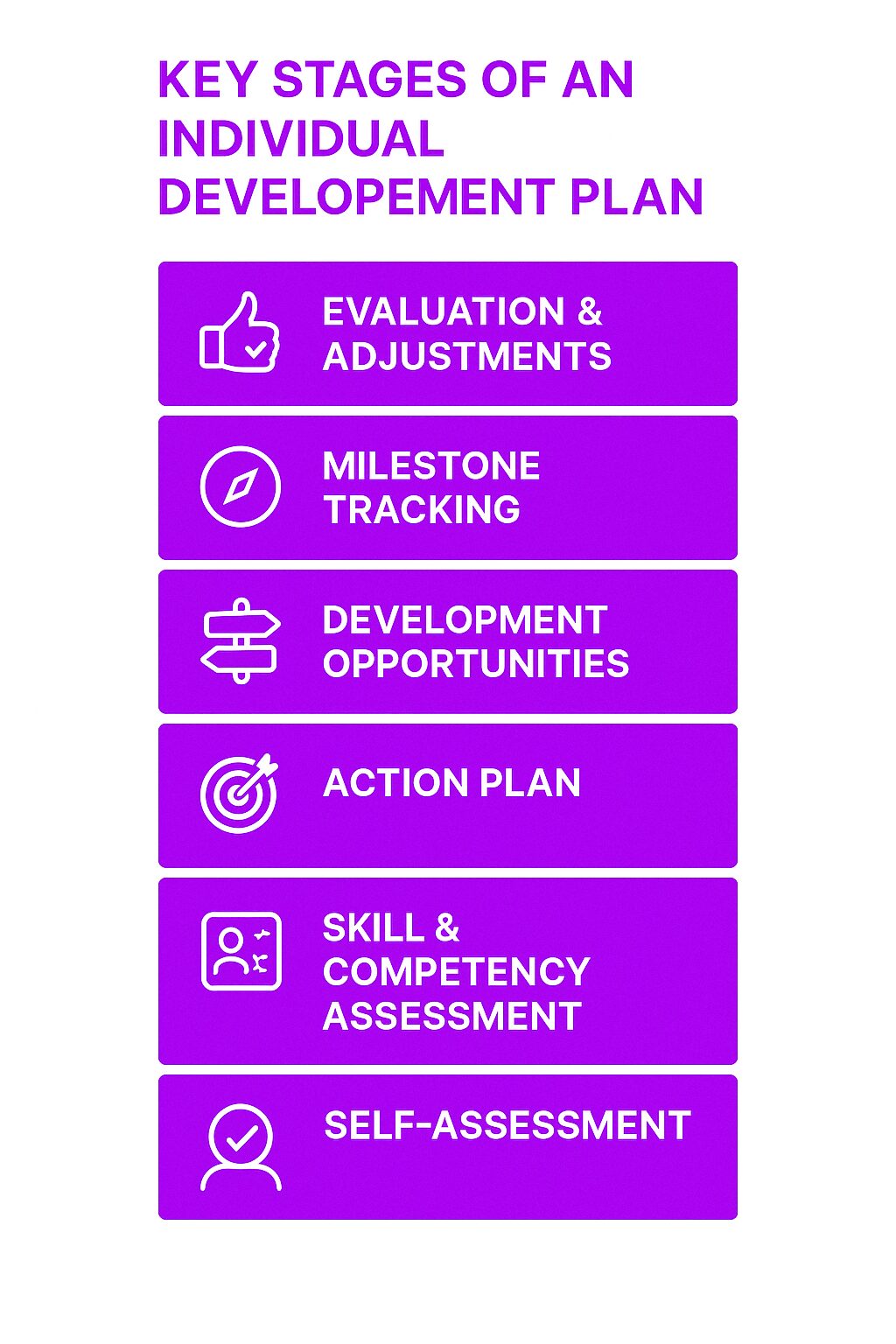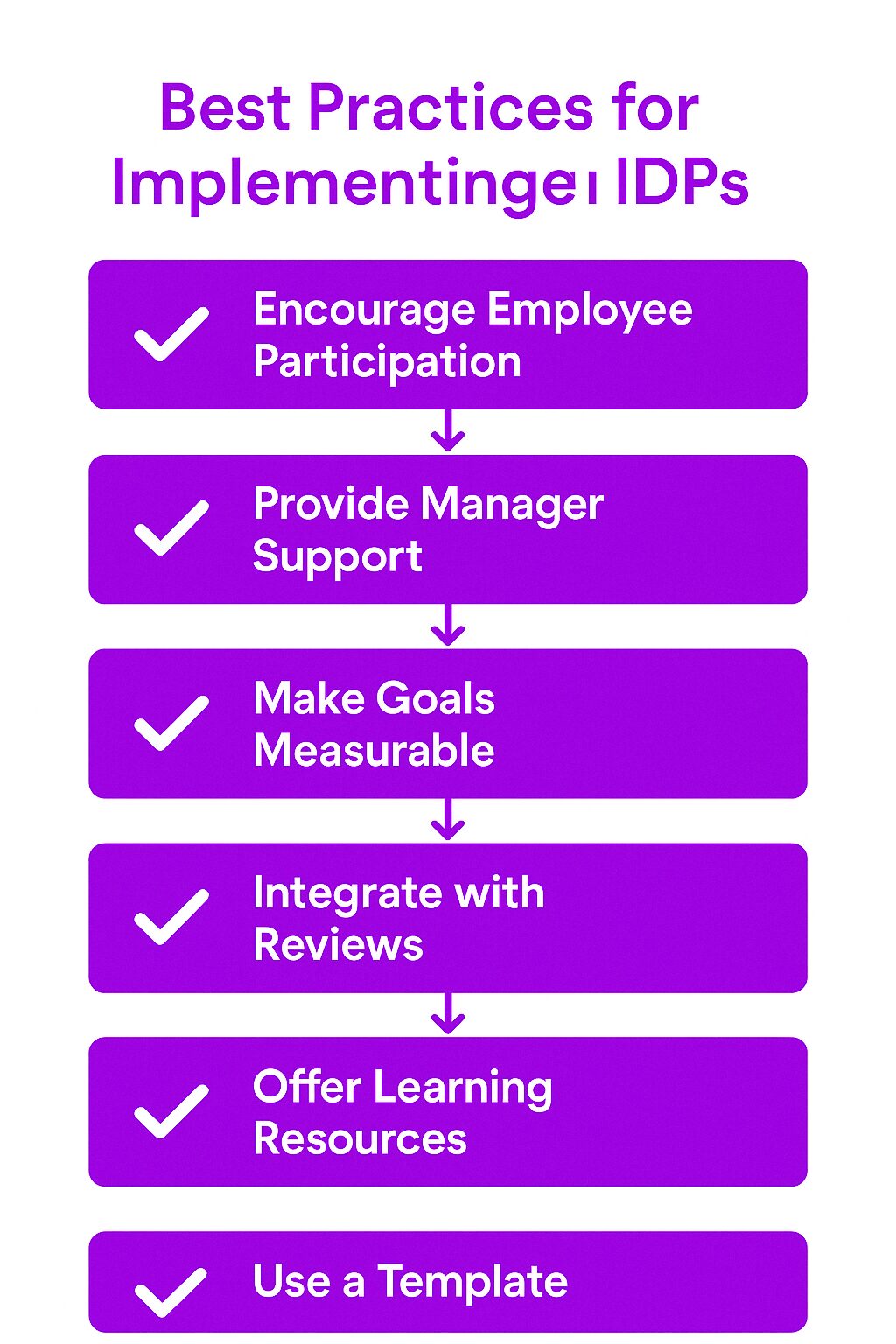What Is an Individual Development Plan?
An Individual Development Plan (IDP), also known as an employee development plan, is a structured approach to career planning that helps employees set goals for professional growth. It outlines specific actions employees can take to develop new skills, improve performance, and achieve long-term career aspirations. Unlike general career planning, an IDP is a formalized process that aligns individual ambitions with organizational objectives.
Employees typically create IDPs in collaboration with their managers or HR teams. The process involves assessing current skills, identifying growth opportunities, and setting measurable objectives. Organizations use IDPs to support workforce development, improve employee engagement, and strengthen talent retention.
How an Individual Development Plan Works
An IDP provides a roadmap for employees to advance their careers while contributing to company goals. It includes personalized strategies for professional development, training, mentorship, and skill-building opportunities.
The plan is typically reviewed and updated periodically, ensuring continuous alignment with career progression and business needs. Organizations use IDPs to foster a culture of learning, helping employees remain competitive in their roles.
Key Stages of an Individual Development Plan
Self-Assessment
Employees start by evaluating their strengths, skills, and areas for improvement as part of the IDP process. Self-assessment tools, feedback from managers, and performance reviews help identify development needs.
Assess Skills and Competencies
Assessing skills and competencies is a crucial step in creating an effective Individual Development Plan (IDP). This involves identifying the employee’s current skills, knowledge, and abilities, as well as the skills and competencies required for their current and future roles. This assessment helps to identify gaps in skills and competencies, which can then be addressed through training, development, and other learning opportunities.
To assess skills and competencies, employees and managers can use a variety of tools and techniques, such as:
-
Skills assessments and inventories
-
Performance reviews and feedback
-
360-degree feedback
-
Competency frameworks and models
-
Job analysis and job descriptions
By assessing skills and competencies, employees and managers can identify areas for development and create a plan to address these gaps. This helps to ensure that employees have the necessary skills and competencies to perform their jobs effectively and to achieve their career goals.
Goal Setting
Setting clear, measurable goals is critical. Goals may include:
-
Acquiring new technical skills.
-
Improving leadership capabilities.
-
Enhancing productivity and efficiency.
-
Preparing for a promotion or career transition.
Action Plan
Employees outline steps to achieve their goals. Identify resources that support goal achievement by breaking down these goals into actionable steps. This can involve:
-
Attending workshops and training sessions.
-
Enrolling in certification programs.
-
Seeking mentorship from senior colleagues.
-
Taking on new responsibilities or cross-functional projects.
Identifying Development Opportunities
Identifying development opportunities is a critical step in creating an effective IDP. This involves identifying opportunities for employees to develop new skills, knowledge, and abilities, as well as opportunities to apply their existing skills and competencies in new and challenging ways.
To identify development opportunities, employees and managers can consider a range of options, such as:
-
Training and development programs
-
Mentorship and coaching
-
Job rotations and assignments
-
Special projects and initiatives
-
Education and certification programs
-
Conferences and workshops
By identifying development opportunities, employees and managers can create a plan to address gaps in skills and competencies, and to provide employees with the opportunities they need to grow and develop in their careers.
Milestone Tracking
Regular check-ins help employees track progress. Reviewing achievements, challenges, and adjustments ensures the plan remains relevant and effective.
Evaluation and Adjustments
An IDP is a living document. Employees and managers revisit and refine the plan based on evolving career aspirations and business needs.
Why an Individual Development Plan Matters
Encourages Continuous Learning
Individual development planning fosters a culture of learning by encouraging employees to acquire new knowledge and skills that benefit both them and their organizations.
Improves Employee Engagement
Employees who see clear growth opportunities are more engaged and motivated. IDPs provide direction and purpose, leading to higher job satisfaction.
Supports Career Progression
IDPs help employees transition into leadership roles by preparing them for greater responsibilities through structured development activities.
Strengthens Workforce Retention
Organizations that invest in employee development experience lower turnover rates. When employees see long-term career prospects, they are more likely to stay with their company.
Aligns Employee Growth With Business Goals
IDPs ensure that individual career aspirations align with the strategic goals of the organization, contributing to organizational success. Companies benefit from a skilled and adaptable workforce.
Benefits and Challenges of an Individual Development Plan
Benefits
Helps Employees Stay Goal-Oriented
A clear plan provides direction, helping employees focus on meaningful professional goals and career objectives.
Improves Productivity
When employees develop relevant skills, they perform their tasks more effectively, increasing workplace productivity.
Encourages Self-Improvement
Employees take ownership of their learning and development, fostering a proactive mindset.
Facilitates Performance Management
Managers use IDPs to guide coaching discussions, making performance reviews more constructive.
Challenges
Requires Commitment From Employees and Managers
IDPs are only effective when both parties actively engage in the process.
Needs Regular Updates
A static IDP can become outdated. Employees and managers must revisit the plan frequently to keep it relevant.
Risk of Generic Plans
A one-size-fits-all approach may not work. IDPs should be customized to meet individual needs.
Best Practices for Implementing an Individual Development Plan
Encourage Employee Participation
Employees should take an active role in shaping their IDP. This ensures alignment with their personal interests and career goals.
Provide Manager Support
Managers play a key role in guiding employees through their development journey. Regular discussions and feedback help employees stay on track.
Make Goals Measurable
Vague objectives lead to unclear progress. Goals should be specific, attainable, and time-bound.
Integrate With Performance Reviews
IDPs should complement performance evaluations, reinforcing growth opportunities and tracking progress.
Offer Access to Individual Development Plan Template
Organizations should provide access to training programs, mentorship, and other learning opportunities to support employee growth. Providing an individual development plan template can facilitate the development process by offering a structured approach and outlining key components necessary for effective planning and personal growth.
Launching the IDP Program
Launching an IDP program requires careful planning and execution. Here are some steps to consider:
-
Communicate the program: Communicate the IDP program to all employees, including the purpose, benefits, and expectations.
-
Provide training and support: Provide training and support to employees and managers on how to create and implement IDPs.
-
Establish a timeline: Establish a timeline for creating and implementing IDPs, including deadlines and milestones.
-
Assign responsibilities: Assign responsibilities for creating and implementing IDPs, including who will be responsible for creating the IDP, who will review and approve the IDP, and who will provide support and resources.
-
Monitor progress: Monitor progress and provide feedback and coaching to employees and managers as needed.
-
Evaluate the program: Evaluate the effectiveness of the IDP program and make adjustments as needed.
By following these steps, organizations can launch a successful IDP program that supports the growth and development of their employees.
Related Concepts
Career Development Plan vs. Individual Development Plan
A career development plan focuses on long-term career aspirations, while an IDP emphasizes immediate skill-building and professional growth within a specific role.
Performance Improvement Plan (PIP) vs. IDP
A PIP addresses performance issues and corrective actions, while an IDP is a proactive tool for career enhancement.
Learning and Development (L&D)
Development plans and L&D programs provide training and resources that align with IDP objectives, fostering skill development and career progression.
Real-World Use Cases of an Individual Development Plan
Leadership Development
Companies use IDPs to identify and prepare future leaders by equipping them with leadership skills and strategic decision-making abilities. Providing positive feedback reinforces employees’ strengths and boosts their confidence, which is crucial for their personal and professional development.
Employee Reskilling and Upskilling
Organizations implement IDPs to help employees adapt to changing job requirements by learning new technologies and industry trends.
Succession Planning
IDPs contribute to succession planning by ensuring that high-potential employees are ready to step into key roles when needed.
Career Transition Support
Employees exploring new career paths within their organization use IDPs to gain the necessary skills and experience for a successful transition.
Final Thoughts
An Individual Development Plan is a valuable tool for employees and organizations. It provides structure for career growth, enhances engagement, and ensures businesses have a capable workforce. With the right approach, IDPs contribute to long-term success for both individuals and companies.







